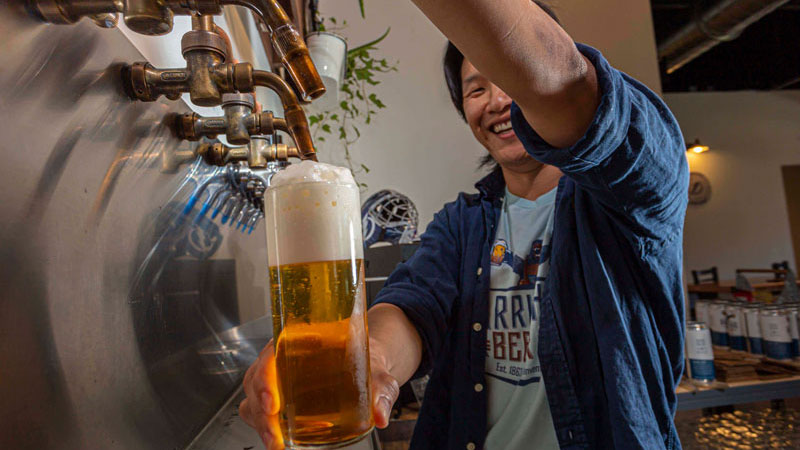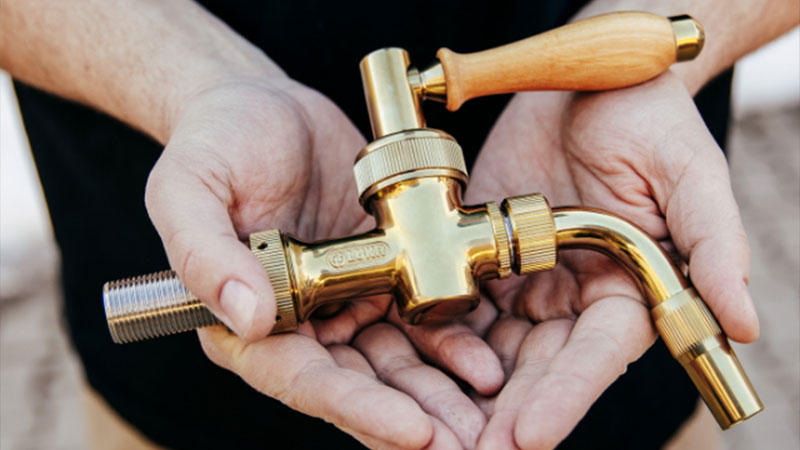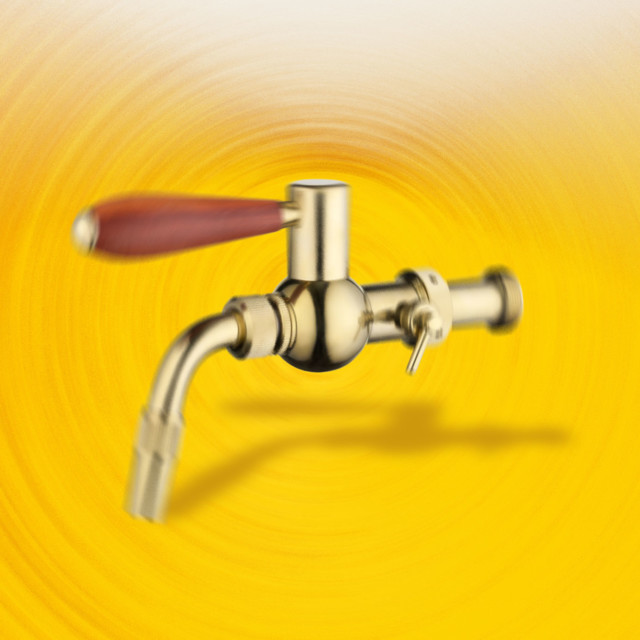With the worldwide success of pilsner being what it is, it’s something of a mystery that aspects of Czech beer culture, which is famously storied and vibrant, are only now starting to filter into America’s craft beer scene.
And while the most obvious indicators of the trend are Czech-style beers, which have been cropping up in breweries over the past year or so, a more interesting aspect of Czech beer culture picking up in the U.S. is the side-pull tap handle.
Rather than the binary open/closed mechanics of your standard tap handle, the side-pull features a ball valve that allows for varying flow rates of beer. That’s paired with a micro-screen that aerates the beer as it emerges from the tap. In the end — and after months of practice — you can get a beer with a thick, picture-perfect creamy head that elevates the aromas and textures of the beer-drinking experience beyond your basic bubbles.
If you haven’t seen at least one side-pull handle pop up at your favorite beer bar or lager-focused brewery, you can probably expect to see one sometime soon. Whether the trend finds an audience among drinkers is yet to be determined, but it’s one capturing brewers’ hearts across the country.
Foam First, Beer Second
One of the pioneers of Czech-style beer and side-pull handles in the U.S. is Chris Lohring. A decade before starting Notch Brewing in 2010 in Salem, Mass., Lohring fell in love with Czech beer following a trip to the Czech Republic, inspired by Michael Jackson (who else) and an episode of his PBS “Beer Hunter” series. “I was enamored. I didn’t know anything about Czech brewing at the time,” Lohring says. “And when I went there, I discovered some of the best beer in the world is 4 percent pale lager. It was incredibly complex and flavorful and wonderful to drink … and the way they were poured was just as interesting.”
The way beers are poured from a side-pull requires a special technique that would appear, to most Americans, to be a mistake from the start: The tap is plunged into the beer during the pour. “I would sit at beer halls and watch the barkeeps pour beer in a way that I’d never seen,” Lohring says. “The faucet went into the beer and poured foam first, then beer second. And the speed at which they did it was just incredible.”
Opening the valve fully allows the beer to flow freely through, while a slight opening releases just foam. A variety of different pours can be ordered from the tapster (as Czech beer servers are called), all with different purposes and occasions.
If you’re adhering to Czech style you’d ask for a hladinka or na dvakrát (a “smooth” or “crisp” pour, with about 75 percent beer and 25 percent foam), a šnyt (a little more foam than beer with space at the top of the glass) and perhaps most famously, the mlíko or “milk” pour: nearly all foam with a bit of beer at the bottom. (Pilsner Urquell, unsurprisingly, has great resources for more on all these pours as part of its network of pubs.)
The side-pull taps also allow for tremendous speed in pouring, but for beer fans in the States who have attended a Great American Beer Festival (GABF) or two, many first side-pull experiences take place at Denver’s Bierstadt Lagerhaus, specifically in a stein of its Slow Pour Pils. Co-owner and head brewer Ashleigh Carter has been serving slow pours since day one, with its inches of towering pillowy foam, after being inspired by a visit to a Pilsner Urquell bar in New York City.
“I just saw this wonderful draft standard with 30 of these f*cking beautiful faucets on there, and I just did everything I could to get a hold of the bar manager there and find out about them,” Carter says. “They were cool as shit. And I knew they poured beer beautifully. And I wanted to look different, and the striking visual of them is part of it.”
The other part of it, for Carter and a growing number of others, is the speed, or lack thereof. “The side-pull wasn’t traditionally meant to pour beer slowly,” she says. “But I love it for pouring beer slowly because I think it really helps build that foam. And I think for pils, it just does an amazing job of opening it up and degassing it slightly, and really giving that light soft bitterness, softening the carbonation.”
One of those GABF attendees who had a life-changing slow-pour experience at Bierstadt was Ryan Ziarko, owner and brewer at Seedz Brewing in Union Pier, Mich. “I remember I ordered a few slow pours at Bierstadt and I was so pissed. I was like, ‘I can’t believe everybody else is getting their beers before me,’” Ziarko says. “And [my friends] were like, ‘No, no, it’s a slow pour.’” And then when I got the beer, [it was] so delicate, so nice, and it just looked good.”
Another brewer converted by Bierstadt is Jim Barrie, owner and head brewer of Tampa, Fla.’s Barriehaus Brewing. “You can’t really mimic the pour that you get with a side-pull. And that’s really important to us. It’s essentially a symbol that a brewery cares about their lagers.” The side-pull also indicates the inroads that craft lager has made in America; 2022 might not be the oft-promised Year of the Lager, but seeing side-pull taps on the rise indicates some additional attention to the process as a whole.

“Lagers are becoming a cool thing again for the craft beer industry, so breweries are becoming more serious and trying to make the best lagers possible,” Barrie says.
Game-Changing Taps
Most of these handles, as well as the gleaming brass towers that house them, come directly from Lukr Faucets in Prague. Jan Havránek, the global sales manager for Lukr, says that since joining the company in 2015, he’s seen a strong, steady climb in North American orders.

“During the last two years it’s picking up a lot more,” Havránek says. “In the beginning it was just for those really deep insiders, pioneers of the beer industry who travel a lot, trying to find something special and they are not too lazy to search for it.” Before setting up Lukr’s online store in March 2021, you either had to fight time differences, language barriers, customs delays, and endless metric/American pneumatic conversions once it got here, or physically get on a plane, go to Prague, and bring them back with you.
Eric Larkin, of the newly opened Cohesion Brewing, also in Denver, discovered the side-pull on a honeymoon trip to Prague. Following a stint at Allagash Brewing and Odd13, he opened Cohesion to bring Czech lager and beer culture to Colorado, and with that came side-pull handles from Lukr purchased on a return visit. “I [told them] I want to leave here with six of these things,” he says. “I want to have them in my possession, just to know that we’re going to be able to put them in.”
As Havránek puts it, “In the beginning, it was only for people who really wanted to get it and understood that it’s a game changer.” Since adding online purchasing, he’s seen around 300 orders come through for the handles, “which is quite good,” he says, but he’s doing more than just selling them a faucet — he wants to export Czech beer culture along with it. “It’s not just about the tap, it’s also about the passion and the love of the bartender. We believe it’s a form of art, doing this. In the States, I’m always happy to see that there are people who are willing to give it a try, to understand what the difference is, and do it the right way.”
Larkin is one of those people: Cohesion beer is brewed with decoction mashing and whole-cone hops; there are chilled, wet mugs at the ready; its beer lists are written in Czech along with Czech pronunciation guides at the bar, ready for a pour from a Lukr faucet. “To me, it was an integral part of representing the Czech beer culture,” Larkin says. “I don’t have any Czech heritage personally, and I’ve only visited the country twice now, but it was really important for me to try and find things that I saw as authentic to what I was seeing in Prague and Pilsen. We were seeing Lukr faucets pretty much everywhere. … To me, it was a no-brainer to bring that piece forward.”
Focusing on the Final Step
It is fairly surprising that, for as much as American brewers and drinkers focus on the liquid coming out of the draft lines, the actual tap itself is almost never considered an integral part of the final product. “There are a couple interesting elements of Czech beer culture,” Larkin says. “They’ve got this saying: ‘The brewer brews the beer, but the tapster makes the beer,” also noting that the towers and faucets are customer-facing, to better show the process and the final formation of these beers at the last second.
“This is the last step in the process,” Carter says. “You thought hard about the malt you use, the hops you use, your water profile … and I think that [the side-pull] is the final step in bringing all these things together. It shows [that] you take it seriously and you want to pour it deliberately and you want it to have an aesthetic to it. And honestly, they’re really good at not wasting beer.”
Prior to opening Seedz, Ziarko was brewing for Burn ‘Em Brewing in nearby Michigan City, and says that the pils on the side-pull contributed to his new brewery’s direction. “We wanted to be an agriculturally driven brewery, and I wanted to specialize in just brewing saison and lagers,” he says. “If we’re going to do things proper, we have to get the proper faucets and proper everything. … The side-pull is just like the icing on the cake. I would say 75 percent [of the flavor] is the brewhouse and the other 25 percent is how it’s served.“
Making the Sell
With American breweries and publicans starting to appreciate the side-pull process, are customers coming along for the ride? “People still complain when they don’t get a shaker pint. We’ve had so many people that wipe all the foam off, throw it on our bar [or] throw it on the ground,” Ziarko says.
Larkin reports a similar level of side-eye, especially when it comes to the mlíko pour: “I charge people money for a full glass of foam, which is still a little mind-bending for some, but [when] most of them try it, they take a sip and they’re like, ‘Oh, that is cool. I do like that.’ I understand the skepticism.”
*Even at pioneering places like Bierstadt and Notch, customers are still being convinced one by one. “It was a lot of customer education [and] I still think it is,” Carter says, “telling people we don’t make an IPA, we just do this one thing and we try to do it as perfectly as possible.“ At Notch, it’s the same story, especially for the odd customer who may feel shorted by the ‘excess’ foam. “It’s fun and educational but it’s still a lot of work,” Lohring says. “There’s a lot of burden on our staff to be able to explain this, but we do not apologize for our point of view. There’s no apologies about how we pour.”
For Barriehaus taproom manager Evan Chavez, a classic Pepsi Challenge-style tasting is a useful tool. “We usually have one of the beers mirrored on a regular tap, so we [can] give [a customer] both of them so they can taste the difference,” he says. “With one beer and one tap, I can change the flow and flavor of this beer tremendously. They’re always blown away.”
Of course, successfully making the sell to skeptical consumers depends on skill. Despite helping to pioneer the side-pull in America, Lohring is a bit hesitant about its increasing levels of adoption. “I have two views on it,” he says. “One is, I’m really thrilled. It’s unique and it showcases lager in a really wonderful way. [But] U.S. brewers really have a pension for taking something and turning it on its head, and I’m afraid it’s going to be looked on as a gimmick. I’m afraid if people don’t do it properly, that the consumer will be turned off and when that happens, and those who are doing it well then have a lot of explaining to do about those who weren’t doing it properly.”
For Havránek, proper technique is paramount. “I see so, so many posts on Instagram and stories. When I see the way they use the taps I’m like, this is not right. This is not what we developed the taps for; this is ugly,” he says. “There are many people who are buying the taps just for the look and because it’s cool to have this type of faucet, but they are not using it right. So I always appreciate customers who really dig into the right function of it.”
Gimmick or not, side-pull handles are on the upswing. And if Americans change the perception and process of side-pull serving, so be it, says Carter. “To me, it was about changing the perception of beer a little bit, but [slow pour] was also my favorite way to drink pils. So why would I want my beer poured that way, and not want to give that same experience to someone else?”
And of other breweries adding a side-pull handle or two, “I’m all for it,” Carter says. ”I think it shows a deliberate nature in serving beer. This is just elevating how we’re doing things,” she adds. But brewer beware: “Give yourself enough drip tray room for it, because those things stick out like six extra inches.”
This story is a part of VP Pro, our free platform and newsletter for drinks industry professionals, covering wine, beer, liquor, and beyond. Sign up for VP Pro now!
